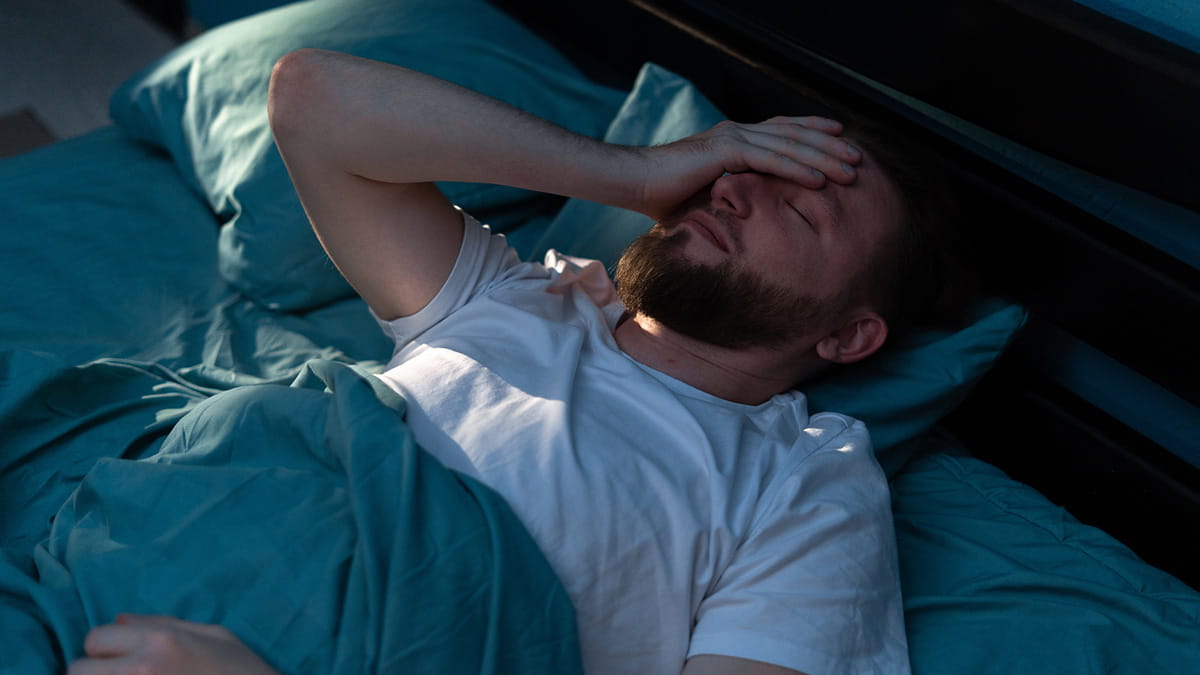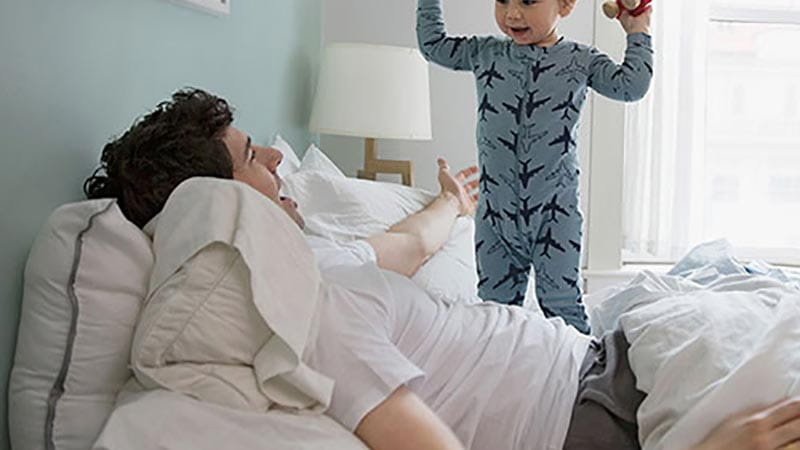Blog article
What is a sleep study, do I need one – and am I covered?

Quality sleep. We all want it, but not all of us are getting it – and with the latest stats showing 48% of Australians reporting two sleep problems1, knowing when to seek slumber support is vital for good health.
So, when do you further investigate with a sleep study? If a desperate lunch break google search of symptoms has led you to the term sleep apnoea, keep reading. This is what you need to know about overnight sleep studies, and how they can lead to diagnosis.
Why is sleep so important anyway?
Sleep is essential for good health because it allows the body and mind to restore, repair, and recharge, supporting everything from immune function to mental clarity.
Getting too much or too little sleep is associated with an increased risk of type 2 diabetes, cardiovascular disease, coronary heart disease, obesity, and death1.
How much sleep is too little, and how much is too much?
Definitions of ‘short’ and ‘long’ sleep have evolved; currently, short sleep is generally defined as fewer than 6 hours per night for adults aged 18–64, and fewer than 5 hours for those aged 65 years and older. Long sleep is classified as more than 11 hours for adults aged 18–25, over 10 hours for those aged 26–64, and more than 9 hours for individuals aged 65 and above.1
When it comes to sleep quality, there’s no single definition of what’s considered “good” or “bad.” But, there are a few common signs to look out for. You might have good sleep quality if you fall asleep easily, stay asleep through the night, don’t wake up often, and spend most of your time in bed actually sleeping. On the other hand, trouble falling asleep, waking up a lot, or spending a lot of time awake in bed could mean your sleep quality isn’t great.
What is Sleep Apnoea?
Sleep apnoea is a common and serious sleep disorder where breathing repeatedly stops and starts during sleep. The most prevalent form, Obstructive Sleep Apnoea (OSA), occurs when the throat muscles intermittently relax and block the airway. These interruptions can last from 10 seconds to over a minute and may happen hundreds of times a night, leading to poor sleep quality and reduced oxygen levels.
Symptoms include loud snoring, gasping during sleep, excessive daytime fatigue, and mood changes. Untreated sleep apnea is linked to serious health risks such as high blood pressure, heart disease, stroke, diabetes, and increased risk of accidents.
Fortunately, sleep apnoea is treatable, often through lifestyle changes, CPAP therapy, or other medical interventions2.
What are sleep studies?
It can be tempting to use an app on your phone to listen to your snoring or ask your partner which type of power tool you sound like, but if you want a true diagnosis of why you’re not getting enough rest you should consider a sleep study.
There are two main types of sleep studies you can undertake to give you a path towards treating your sleep issues.
At-home sleep studies, which are performed in your own bed, test for breathing-based disorders and can give you an indication of sleep apnoea, but they can’t go further to look at other potential sleep issues. If you’re doing a sleep study at home, you’ll visit your clinic during the day to get some sensors attached, then head home and sleep in your own bed as usual. The equipment keeps track of your breathing and movements overnight - so you can get checked out without leaving your comfort zone3.
A hospital-based sleep study, which captures more types of data and is video recorded and supervised by a sleep scientist, may provide deeper analysis.
To determine what sort of sleep study is appropriate, you should consult your GP, who can refer you for the right test.
But what is it like at the hospital? Will it be easy to sleep? Will there be a one-way mirror with people in white coats on the other side watching you sleep under a dim blue light? Thankfully, you can file that image away with other fears that may be keeping you wide-awake – here’s what to expect.
Getting ready for an overnight hospital sleep study3
It is normal to have questions about how the sleep study will be conducted and to feel a little anxious about it. Overnight sleep studies at a clinic are not painful though, and while we’re not going to compare them to a hotel stay – you are in a private room with a bathroom and plenty of opportunity for television and winding down. Your team on the night are very experienced, and conscious that the equipment shouldn’t prevent you from sleeping in any way.
Patients are always reassured by their clinic they will be able to sleep and there may be the option to have a mild sedative if they are a bit nervous.
If you’re someone who relishes in the detail though, here is a breakdown of what’s being studied. When you sleep you have several wires attached to you to monitor the different aspects of your sleep:
- EEG wires attached to the head
- ECG electrodes for monitoring the heart
- Electrodes to monitor muscle tone
- Electrode to monitor muscle tone
- A finger probe for oxygen
- A cannular to measure the pressure of breath
- Electrodes near the eyes to measure rapid eye movement to detect dreaming
"They shouldn’t feel it if they roll and feel the pull of the wires. If they do feel uncomfortable they should tell us.
"If you want to use the bathroom you can have them taken off during the night. There are sleep technologists available to ensure the data we collect is the best quality and the patient is comfortable."
The sleep clinic is set up like a hotel with a bathroom, a bed and a TV in a private room. The only difference being that you bring your own pillow, food and drink.
Patients are encouraged to do whatever it is they would do at home — whether that is having a glass of wine, watching TV or using their laptop.
Get prepared for the study by keeping as close to the home routine as possible:
- Don’t consume any caffeine
- Wear two-piece pyjamas
- Bring your usual pillow (highly recommended)
- Bring your toiletries
- Bring reading materials and electronic devices
Why you might need an overnight hospital sleep study
For the extra convenience and cost, it is worth comparing the added benefit of the hospital-based study when compared with the home study.
The main differences between an at-home and an in-hospital sleep study is the technology used to monitor your sleep and the expertise available.
Your GP or another specialist might refer you to a clinic if they think your sleep is affected significantly beyond sleep apnoea.
A hospital-based sleep study (polysomnograph), covers a range of things2:
- Quantity and quality of sleep stages
- Measure of oxygen saturation and breathing
- Correlation of breathing pauses and waking arousals
- Record restless legs and Periodic Limb Movements of Sleep (PLMS)
- Monitor ECG
- Assess degree of sleep fragmentation
- Detect sleep apnoea and other sleep disordered breathing
- Diagnose REM behaviour disorder
- Diagnose parasomnias
- Record sleep position (e.g. back vs side)
- Monitor and record sound
Following your night in the hospital, your data is analysed and reviewed by the sleep specialists and usually the results are available within a week.
Typically the results are given directly to the patient where treatment options are discussed, but they can also be given back to the patient’s GP for review.
Am I covered?
By now, you’re probably wondering – but what’s the cost? HBF offer hospital cover options that include overnight sleep studies. We’re here to help you seek a sleep disorder diagnosis and can guide you in choosing a hospital and understanding the cost involved.
